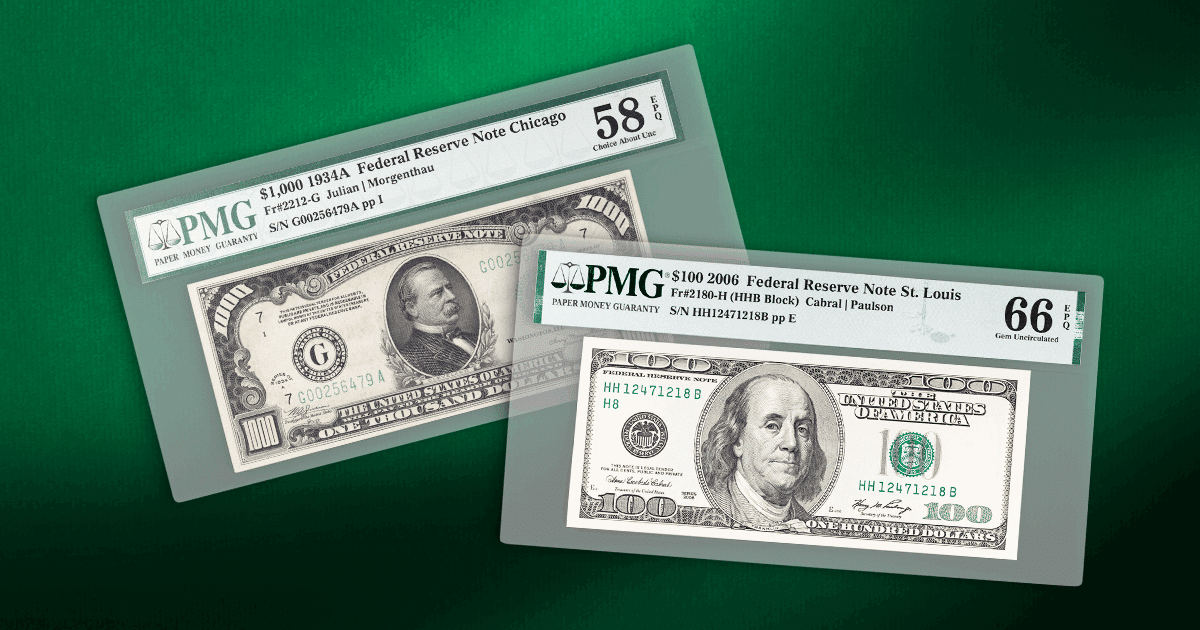
The largest denomination of U.S. currency is the $100 bill. Before 1969, the $10,000 bill was the largest circulating denomination of United States currency, but it was not the largest denomination issued.
Large Currency Denominations Throughout the Years
North Carolina Notes and the Revolutionary War
In 1780, North Carolina issued the first $500 note as part of a concentrated effort to finance the Revolutionary War. The first $500 note was soon followed by $1,000 and $2,000 notes, which reflected the urgent need to facilitate trade.
The high-denomination North Carolina notes were followed by Virginia notes of the same denominations in 1780 and 1781.
These notes were issued during a time of significant financial strain to alleviate economic instability during the Revolutionary War and finance military operations. However, achieving these goals was a challenge.
Rapidly issuing large denomination notes caused runaway inflation, diminishing their value and adding to the economic instability of the time. To make matters worse, counterfeiting became rampant, which further eroded confidence in the new nation’s currency. By the end of the Revolutionary War, it is estimated that many of the high denomination notes were worth as little as 10% of their face value.
The War of 1812
During the War of 1812, the United States again needed funding for military operations and issued high-denomination notes. In this instance, the highest denomination was a $1,000 Treasury note, which was issued along with $100 Treasury notes. The notes bore a 5.4% interest rate and large notes were redeemable in gold. They were a success and sold out quickly.
The large denomination Treasury notes were issued from 1812 through 1814 and printed in Philadelphia by Murray, Draper, Fairman & Co. They helped to bridge the gap between the war expenses and ongoing economic instability.
The Civil War
The Civil War saw the first greenback notes issued, which were backed by the U.S. government but not by gold. Congress authorized them on July 17, 1861, to help finance the war effort and issued them in $500, $1,000, and $5,000 denominations.
The greenbacks were effective in providing economic stability for the Union and in helping the U.S. government raise significant funds. Escalating costs during the Civil War required consistent issuance of the greenback, which led to long-term inflationary consequences.
Gold Certificates
Following the end of the Civil War in 1865, the U.S. began issuing gold certificates. Gold certificates were issued in $100, $1,000, $10,000, and $100,000 denominations. The $100,000 gold certificate was the largest denomination of U.S. currency ever issued and was used to facilitate large-scale transactions between government agencies. It depicted President Woodrow Wilson, and of the 42,000 $100,000 notes, there are no instances of one circulating outside of government channels.
1934-Present
The final large denomination U.S. currency notes were printed in 1945, though they were officially discontinued in 1969. In July of 1969, the Federal Reserve began removing and destroying large denomination notes.
By 2009, only 336 $10,000 bills and 342 $5,000 bills were known in existence. At that time, there were many more $1,000 notes known, a little more than 165,000. Because of their rarity, many are worth more than their face value. As recently as 2013, the Federal Reserve reported holding $11.037 billion in $100,000 gold certificates.




